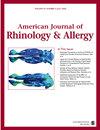基于FIB、PCT、hs-CRP、Th17/Treg-IL10/IL-17轴平衡表达的变应性鼻炎发病机制研究
IF 2.5
3区 医学
Q1 OTORHINOLARYNGOLOGY
引用次数: 1
摘要
背景:变应性鼻炎(allergic rhinitis, AR)的发病机制尚不明确,但多种免疫细胞和细胞因子在其发生发展中起着至关重要的作用。目的:探讨外源性白细胞介素-10 (IL-10)对急性鼻炎大鼠鼻黏膜纤维蛋白原(FIB)、降钙素原(PCT)、超敏c反应蛋白(hs-CRP)表达及Th17/Treg-IL10/IL-17轴平衡的影响。方法:将48只雌性无病原体Sprague-Dawley大鼠随机分为空白对照组、急性鼻炎组和IL-10干预组。在AR组和IL-10组分别建立AR模型。对照组大鼠灌胃生理盐水;AR组大鼠每日给予含卵白蛋白50 μg的生理盐水20 μL。IL-10干预组大鼠腹腔注射40 pg/kg IL-10 1 mL,并给予卵细胞;IL-10干预组由AR小鼠接受IL-10治疗组成。观察鼻腔过敏症状(如鼻痒、打喷嚏、流鼻涕)的行为及鼻黏膜苏木精和伊红染色。采用酶联免疫吸附法检测血清FIB、PCT、hs-CRP、IgE、OVA sIgE水平。流式细胞术检测血清中Treg和Th17细胞水平。Western-blot法检测大鼠鼻黏膜TGF-β、IL-10、IL-17蛋白水平。结果:AR组患儿流鼻涕、鼻痒、打喷嚏得分均显著高于对照组,而IL-10干预组患儿上述症状得分均低于AR组。AR组患者血清FIB、PCT、hs-CRP、IgE、OVA sIgE水平及鼻黏膜IL-10、IL-17蛋白水平均高于空白对照组。同时,IL-10组患者血清FIB、PCT、hs-CRP、IgE、OVA sIgE水平及鼻黏膜IL-10、IL-17蛋白水平均低于AR组。结论:IL-10可通过影响AR大鼠鼻黏膜中FIB、PCT、hs-CRP的表达及Th17/Treg-IL10/IL-17轴的平衡来缓解AR大鼠的过敏反应。本文章由计算机程序翻译,如有差异,请以英文原文为准。
Study on the Mechanism of Allergic Rhinitis Based on the Expression of FIB, PCT, hs-CRP, and Th17/Treg-IL10/IL-17 Axis Balance.
Background The pathogenesis of allergic rhinitis (AR) is ambiguous, while it is clear that various immune cells and cytokines play crucial roles in its occurrence and development. Aim To investigate the effect of exogenous interleukin-10 (IL-10) on the expression of fibrinogen (FIB), procalcitonin (PCT), hypersensitive C-reactive protein (hs-CRP), and Th17/Treg-IL10/IL-17 axis balance in the nasal mucosa of rats with AR. Method In this study, 48 female-specific pathogen-free Sprague–Dawley rats were randomly divided into 3 groups: blank control group, AR group, and IL-10 intervention group. The AR model was established in the AR group and IL-10 group. The rats in the control group were treated with normal saline; the rats in the AR group were given 20 μL of saline containing 50 μg of ovalbumin (OVA) every day. The rats in the IL-10 intervention group were intraperitoneally injected with 1 mL of 40 pg/kg IL-10 and provided with OVA. The IL-10 intervention group was composed of mice with AR that received IL-10. The behavior of nasal allergic symptoms (such as nasal itching, sneezing, and runny nose) and the hematoxylin and eosin staining of nasal mucosa were observed. The levels of FIB, PCT, hs-CRP, IgE, and OVA sIgE in serum were determined by enzyme-linked immunosorbent assay. The levels of Treg and Th17 cells in serum were detected by flow cytometry. The protein levels of TGF-β, IL-10, and IL-17 in nasal mucosa were detected by the Western-blot method. Results The scores of snots, nasal itching, and sneezing in the AR group were significantly higher than those in the control group, while the scores of the above symptoms in the IL-10 intervention group were lower than those in the AR group. The levels of FIB, PCT, hs-CRP, IgE, and OVA sIgE in serum and the protein levels of IL-10 and IL-17 in the nasal mucosa in the AR group were higher than those in the blank control group. Meanwhile, the levels of FIB, PCT, hs-CRP, IgE, and OVA sIgE in serum and IL-10 and IL-17 protein in the nasal mucosa in the IL-10 group were lower than those in the AR group. Conclusion IL-10 can relieve the allergy of AR rats by affecting the expression of FIB, PCT, and hs-CRP, as well as the balance of the Th17/Treg-IL10/IL-17 axis in the nasal mucosa of AR rats.
求助全文
通过发布文献求助,成功后即可免费获取论文全文。
去求助
来源期刊
CiteScore
5.60
自引率
11.50%
发文量
82
审稿时长
4-8 weeks
期刊介绍:
The American Journal of Rhinology & Allergy is a peer-reviewed, scientific publication committed to expanding knowledge and publishing the best clinical and basic research within the fields of Rhinology & Allergy. Its focus is to publish information which contributes to improved quality of care for patients with nasal and sinus disorders. Its primary readership consists of otolaryngologists, allergists, and plastic surgeons. Published material includes peer-reviewed original research, clinical trials, and review articles.

 求助内容:
求助内容: 应助结果提醒方式:
应助结果提醒方式:


